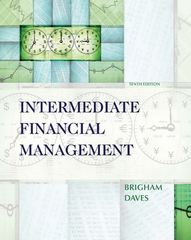Question
4. The following is excerpted form an article about a U.S. Treasury auction of one-month bills that resulted in a zero-percent yield. When was the
4. The following is excerpted form an article about a U.S. Treasury auction of one-month bills that resulted in a zero-percent yield.
When was the last time you invested in something that you knew wouldnt make money? In the market equivalent of shoveling cash under the mattress, hordes of buyers were so eager on Tuesday to park money in the worlds safest investment, United States government debt, they agreed to accept a zero-percent rate of return. The news sent a sobering signal: in these troubled economic times, when people have lost vast amounts on stocks, bonds and real estate, making an investment that offers security but no gain is tantamount to coming out ahead.
Investors accepted the zero-percent rate in the governments auction Tuesday of $30 billion worth of short-term securities that mature in four weeks. Demand was so great even for no return that the government could have sold four times as much. In addition, for a brief moment, investors were willing to take a small loss for holding another ultra-safe security, the already-issued three-month Treasury bill.
In these times, it seems, the abnormal has now become acceptable. As Americas debt and deficit spiral from a parade of billion dollar bailouts and stimulus packages, fund managers, foreign governments and big retail investors reckon they will get more peace of mind by stashing their cash, rather than putting it toward any of the higher-yielding risk that is entailed in stocks, corporate bonds and consumer debt.
The last time this happened was the Great Depression, when people are willing to accept no return on their money, or possibly even a negative return, said Edward Yardeni, an independent analyst. If people are so busy during the day just protecting the cash they have, its not a good sign.
There are several explanations for the flight to safety in the bond market. The world of short-term money market funds, for instance, is still reeling from troubles at the Reserve Primary Fund, a money market fund frozen in September after it lost money on investments in Lehman Brothers. Since then, individual and large investors have put more than $200 billion into money funds that only invest in safe Treasury bills. At the same time, investors have withdrawn nearly $400 billion from prime funds. Many investors are also pulling money out of mutual funds and hedge funds, forcing portfolio managers to sell more risky assets and hold Treasuries, which are easier to sell. [Investors Buy U.S. Debt at Zero Percent, Vikas Bajaj and Michael Grynbaum; NYT, 12-10-2008]
(a) Why is a zero yield on treasury bills equivalent to putting currency under the mattress? How could the existence of money market funds committed to invest in only treasury bills explain why the short-term yields could be negative?
(b) How could you determine if investors are expecting deflation over the next several months? What are the implications for risk premiums on bank time deposits? Carefully explain.
Step by Step Solution
There are 3 Steps involved in it
Step: 1

Get Instant Access to Expert-Tailored Solutions
See step-by-step solutions with expert insights and AI powered tools for academic success
Step: 2

Step: 3

Ace Your Homework with AI
Get the answers you need in no time with our AI-driven, step-by-step assistance
Get Started


